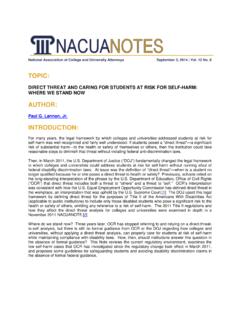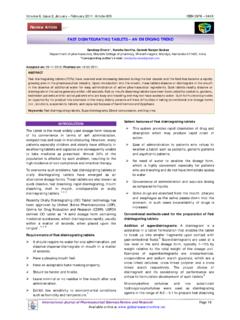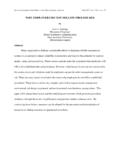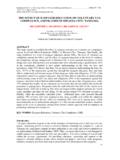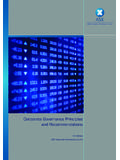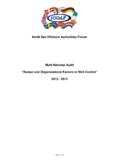Transcription of Off-Campus Harassment: Identifying the …
1 URMIAOff- campus harassment : Identifying the geographical reach of Title IX Compliance2013 URMIA journal Reprint Paula A. Barran Barran Liebman, LLP Jeffrey D. JonesBarran Liebman, LLPU niversity Risk Management and Insurance AssociationOut of this nettle - danger - we pluck this flower - safety. William shakEsPEarE (1564 1616),PoEt and PlayWriGht 25 URMIA journal 2013 Abstract: Under Title IX, colleges and universities must work to prevent discrimination and sexual harassment in their programs and activities. However, what is the duty of colleges and universi-ties to prevent such harassment during Off-Campus activities or programs? This article provides a survey of different cases in which harassment occurred off campus and what the findings of the courts were in those cases.
2 With this information and helpful best practices for managing both on- and Off-Campus discrimination, higher educa-tion risk managers will be better equipped to manage and mitigate the risks of harass-ment of their constituents, wherever such harassment may occur. IntroductionWe tend to think our Title IX responsi-bility stops when we cross the street that separates campus from the real world when, in fact, the law is more intricate and complicated. This confusion often causes institutions to limit their monitor-ing and oversight to the four corners of the campus . The error in this view is obvious when we consider that Title IX applies to any education program or activity, defined as all of the opera-tions of educational Lots of school programs and activities occur off campus ; some take place in other cities, states, and countries.
3 It is pretty obvious that educational institutions have to prevent sexual harassment in their own programs and activities wherever they occur, but what about student activities in which schools aren t involved, especially activities or events happening off campus ?Consider the case of Rouse v. Duke In the early morning hours of an Off-Campus house party, Ms. Rouse said she was raped by a person who was unaffili-ated with Duke. Rouse sued Duke under Title IX, alleg-ing a hostile educational environment. Duke first moved, unsuccessfully, to dismiss the claim. The district court eventually granted a later motion for summary judgment. How could Duke possibly be held responsible for these events? The school argued it had no power to monitor private house parties thrown or attended by its students and that it couldn t control the assailant, who wasn t even known by any Duke officials.
4 Nonetheless, the district court assumed without deciding that an educational institution s response to an Off-Campus rape by an unaffiliated third party may trigger Title IX institu-tional liability, either by direct acts or by deliberate indifference as defined by the Supreme Court. The district court s decision to enter-tain Rouse s Title IX claim in the first place creates much worry but offers little wisdom for educational institutions. The court offers no guidance on when an educational institution might have Title IX responsibilities for personal off-cam-pus student activities. To be sure, there were some unique allegations. The plain-tiff alleged that she was raped at a party hosted by a university fraternity which was under the university s control and that the university had reason to believe the hosts provided alcohol to under-age guests.
5 She also alleged that there was on- campus fallout from the rape and her decision to report it. While we probably can t do much to minimize the expense of defending claims like this, the costs of even-tually securing a dismissal of such claims should buy educational institutions greater insight into how legally to protect themselves (and their students) when students are harmed during personal Off-Campus conduct. Paula A. Barran and Jeffrey D. Jones, Barran Liebman, LLPOff- campus Harassment: Identifying the geographical reach of Title IX ComplianceEducational institutions have to prevent sexual harassment in their own programs and activities wherever they occur, but what about student activities in which schools aren t involved, especially activities or events happening off campus ?
6 26 URMIA journal 2013 Here are some analytical steps and practical recom-mendations to help educational institutions gauge their Title IX responsibilities when students meander off campus . This advice will also help educational institutions understand when they need to take action to satisfy their legal Thinking, On- campus vs. Off-Campus To hold an educational institution liable for damages for sexual harassment under Title IX, a plaintiff must show that an official with authority to address harassment had actual knowledge of, and was deliberately indifferent to, harassment that deprived the victim of access to the edu-cational benefits or opportunities provided by the Title IX damages liability is limited to circumstances where the educational institution exercises substantial control over both the harasser and the environment in which the harassment occurs.
7 This limitation is especially important for claims of Off-Campus sexual harassment . Whether an educational institution has the requisite con-trol will depend on who is doing the harassing ( , teach-er, staff member, another student, an unaffiliated third party) and where and when the harassment occurs ( , school-sponsored Off-Campus program, informal gather-ing initiated by school faculty or staff, wholly private gathering with no formal or informal school involvement). Certainly, it is easier to see that on- campus events are more likely to lead to liability than off- campus events, but the analysis doesn t end there. Start Thinking, How Much Control Do We Have Over the Situation? The control aspect of Title IX undercuts the view that geographical borders alone define an educational institu-tion s Title IX liability.
8 Instead, educational institutions need to consider the people and places it can legitimately influence to minimize the risks of discrimination. The Supreme Court has usefully broken down at least three contexts of sexual harassment with generally differing degrees of institutional control: staff-student harassment , student-student harassment , and proxy harassment , where, much like association discrimination, one student claims to have suffered sexual harassment by unaffiliated individuals associated with another is where this is headed: it is easiest to show the requisite control in staff-student sexual harassment . So far, courts have rejected proxy harassment as too far beyond the control of educational institutions. Whether the requisite control is present in student-student sexual harassment claims depends on the specific context in which harassment Control Staff-Student harassment , So Act Like ItEducational institutions are most in control when the offender is an agent of the school itself.
9 This was true in Gebser v. Lago Vista Independent School Dist., 524 274 (1998), a leading case on Title IX sexual harassment . Alida Star Gebser was a high school student who had sex with a teacher both on and off school property. Gebser never reported the relationship. The school district ter-minated the teacher when it learned of the relationship, but Gebser sued under Title IX anyway. The Gebser case articulated the degree of control necessary for an educa-tional institution to be liable for teacher-student harass-ment. Notably, the Gebser majority held that a plaintiff may not rely upon respondeat superior that the teacher s actions should be treated as the school s actions to establish a Title IX claim. Instead, the majority held that the only theory upon which damages liability may lie is if the school district is directly liable for its deliberate indifference to sexual harassment , assuming control and knowledge.
10 Direct liability holds an educational institu-tion responsible for its own failure to act within the span of its control in the face of knowledge that harassment is couple of recent Off-Campus sexual harassment cases clarify the degree of control needed to hold an educational institution liable for staff-student and Beer Pong Don t MixHunt v. Forbes and the Illinois State University, 2010 WL 1687863 (C. D. 2010), highlights the many risks surround-ing informal staff-student interaction. Defendant Michael Forbes was a tuba professor at Illinois State University (ISU) who perhaps enjoyed Off-Campus student house parties way too much. Several years before plaintiff Megan Hunt s claim, another female student had made two complaints against Forbes conduct toward her at two separate student house parties.



